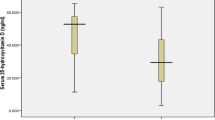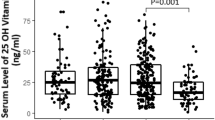Abstract
Purpose
To investigate the correlation between the level of 25-hydroxyvitamin D [25-(OH)D] and community-acquired pneumonia (CAP) in elderly patients.
Methods
A total of 163 older patients were chosen from those hospitalized between October 2011 and October 2012. Patients were divided into pneumonia and non-pneumonia groups, and the concentrations of 25-(OH)D (nmol/L) in serum were measured. Clinical data were then compared between the two groups and pneumonia-related risk factors were analyzed using logistic regression.
Results
Among the 163 older hospitalized patients, 49 suffered from pneumonia. Levels of 25-(OH)D, total cholesterol (TC), and low-density lipoprotein cholesterol (LDL-C) were lower (P < 0.05) in the pneumonia group, while severe vitamin D (VitD) deficiency was higher in the pneumonia group (71.4 vs. 19.3%; P < 0.0001). Age and number of hospitalization days were higher in the pneumonia group (P < 0.05). Multivariate logistic regression showed that age and VitD levels were independent risk factors for pneumonia. No significant difference was observed in terms of gender, onset season, body mass index, or smoking and drinking history between the two groups (P > 0.05).
Conclusion
The older patients with CAP had a severe VitD deficiency, indicating that low levels of VitD might play an important role in the occurrence and development of CAP.
Zusammenfassung
Ziel
Ziel war es, die Korrelation zwischen dem Wert für 25-Hydroxyvitamin D [25-(OH)D] und ambulant erworbener Pneumonie bei älteren Patienten zu untersuchen.
Methoden
Zwischen Oktober 2011 und Oktober 2012 wurden insgesamt 163 ältere Patienten aus den stationär behandelten Patienten ausgewählt. Die Patienten wurden in eine Pneumoniegruppe und eine Gruppe ohne Pneumonie eingeteilt und die Konzentration von 25-(OH)D (nmol/l) im Serum gemessen. Dann wurden die klinischen Daten zwischen den beiden Gruppen und die pneumoniebezogenen Risikofaktoren unter Einsatz der logistischen Regressionsanalyse ausgewertet.
Ergebnisse
Von den 163 älteren stationär behandelten Patienten litten 49 an einer Pneumonie. Die Werte für 25-(OH)D, Gesamtcholesterin und Low-Density-Lipoprotein-Cholesterin waren in der Pneumoniegruppe niedriger (p < 0,05), während ein schwerer Vitamin-D-Mangel dort häufiger auftrat als in der anderen Gruppe (71,4 vs. 19,3 %; p < 0,0001). Alter und Anzahl der Krankenhaustage waren in der Pneumoniegruppe höher als in der Gruppe ohne Pneumonie (p < 0,05). Die multivariate logistische Regression zeigte, dass Alter und Vitamin-D-Werte unabhängige Risikofaktoren für eine Pneumonie darstellten. Es wurde kein signifikanter Unterschied in Bezug auf Geschlecht, Jahreszeit bei Krankheitsbeginn, Body-Mass-Index oder Raucher- und Alkoholanamnese zwischen den beiden Gruppen festgestellt (p > 0,05).
Schlussfolgerung
Die älteren Patienten mit ambulant erworbener Pneumonie wiesen einen schweren Vitamin-D-Mangel auf, was darauf hinweist, dass niedrige Vitamin-D-Spiegel eine wichtige Rolle bei dem Auftreten und der Entstehung einer ambulant erworbenen Pneumonie spielen könnten.
Similar content being viewed by others

References
Pu C, Sun TY, He B, Zeng P (2007) Study of risk factors for community-acquired pneumonia in the elderly. Chin J Geriatr 26(12):918–921
Liu PT, Stenger S, Li H, Wenzel L, Tan BH, Krutzik SR, Ochoa MT, Schauber J, Wu K, Meinken C, Kamen DL, Wagner M, Bals R, Steinmeyer A, Zügel U, Gallo RL, Eisenberg D, Hewison M, Hollis BW, Adams JS, Bloom BR, Modlin RL (2006) Toll-like receptor triggering of a vitamin D‑mediated human antimicrobial response. Science 311(5768):1770–1773
Martineau AR, Wilkinson RJ, Wilkinson KA, Newton SM, Kampmann B, Hall BM, Packe GE, Davidson RN, Eldridge SM, Maunsell ZJ, Rainbow SJ, Berry JL, Griffiths CJ (2007) Single dose of vitamin D enhances immunity to mycobacteria. Am J Respir Crit Care Med 176(2):208–213
Naalouf NM (2008) The noncalciotropic actions of vitamin D: recent clinical developments. Curr Opin Nephrol Hypertens 17(4):408–415
Lips P, Hosking D, Lippuner K, Norquist JM, Wehren L, Maalouf G, Ragi-Eis S, Chandler J (2006) The prevalence of vitamin D inadequacy amongst women with osteoporosis: an international epidemiologicalinvestigation. J Intern Med 260(3):245–254
Flicker L, Mead K, MacInnis RJ, Nowson C, Scherer S, Stein MS, Thomasx J, Hopper JL, Wark JD (2003) Serum vitamin D and falls in older women in residential care in Australia. J Am Geriatr Soc 51(11):1533–1538
Chinese Society of Respiratory Diseases (2006) Diagnosis and treatment of community acquired pneumonia guide. Chin J Tuberc Respir 29(10):651–655
Hathcock JN, Shao A, Vieth R, Heaney R (2007) Risk assessment for vitamin D. Am J Clin Nutr 85(1):6–18
Deluca HF (2004) Overview of general physiologic features and functions of vitamin D. Am J Clin Nutr 80(Suppl):1689S–1696S
Lu D, Yin F, Zhang J, Yue Y, Yu C, Zhu H, Jiang Y, Liu Y (2013) Analysis of the nutritional status of vitamin D and related research in hospitalized elderly patients. Chin J Endocrinol Metab 29(3):245–247
White AN, Ng V, Spain CV, Johnson CC, Kinlin LM, Fisman DN (2009) Let the sun shine in: effects of ultraviolet radiation on invasive pneumococcal disease risk in Philadelphia, Pennsylvania. BMC Infect Dis 9:196
Remmelts HH, van de Garde EM, Meijvis SC, Peelen EL, Damoiseaux JG, Grutters JC, Biesma DH, Bos WJ, Rijkers GT (2012) Addition of vitamin D status to prognostic scores improves the prediction of outcome in community-acquired pneumonia. Clin Infect Dis 55(11):1488–1494
Leow L, Simpson T, Cursons R, Karalus N, Hancox RJ (2011) Vitamin D, innate immunity and outcomes in community acquired pneumonia. Respirology 16(4):611–666
Berry DJ, Hesketh K, Power C, Hyppönen E (2011) Vitamin D status has a linear association with seasonal infections and lung function in British adults. Br J Nutr 106(9):1433–1440
Kash JC, Tumpey TM, Proll SC, Carter V, Perwitasari O, Thomas MJ, Basler CF, Palese P, Taubenberger JK, García-Sastre A, Swayne DE, Katze MG (2006) Genomic analysis of increased host immune and cell death responses induced by 1918 influenza virus. Nature 443(7111):578–581
Ardizzone S, Cassinotti A, Trabattoni D, Manzionna G, Rainone V, Bevilacqua M, Massari A, Manes G, Maconi G, Clerici M, Bianchi Porro G (2009) Immunomodulatory effects of 1,25-dihydroxyvitamin D3 on TH1/TH2 cytokines in inflammatory bowel disease: an in vitro study. Int J Immunopathol Pharmacol 22(1):63–71
Peterson CA, Heffernan ME (2008) Serum tumor necrosis factor-alpha concentrations are negatively correlated with serum 25(OH)D concentrations in healthy women. J Inflamm 5:10
Rodríguez Sangrador M, Beltrán de Miguel B, Quintanilla Murillas L, Cuadrado Vives C, Moreiras Tuny O (2008) The contribution of diet and sun exposure to the nutritional status of vitamin D in elderly Spanish women: the five countries study. Nutr Hosp 23(6):567–576
Hansdottir S, Monick MM, Hinde SL, Lovan N, Look DC, Hunninghake GW (2008) Respiratory epithelial cells convert inactive vitamin D to its active foi’In:potential effects on host defens. J Immunol 181(10):7090–7099
Muscarella S, Filabozzi P, D’Amico G, Mascia ML, Annese MA, Scillitani A, Carnevale V (2006) Vitamin D status in inpatients admitted to an internal medicine department. Horm Res 66(5):216–220
Sabetta JR, DePetrillo P, Cipriani RJ, Smardin J, Burns LA, Landry ML (2010) Serum 25-hydroxyvitamin d and the incidence of acute viral respiratory tract infections in healthy adults. PLOS ONE 5(6):e11088
Remmelts HH, Spoorenberg SM, Oosterheert JJ, Bos WJ, de Groot MC, van de Garde EM (2013) The role of vitamin D supplementation in the risk of developing pneumonia: three independent case-control studies. Thorax 68(11):990–996
Author information
Authors and Affiliations
Corresponding author
Ethics declarations
Conflict of interest
D. Lu, J. Zhang, C. Ma, Y. Yue, Z. Zou, C. Yu, and F. Yin declare that they have no competing interests.
The experiments comply with the current laws of China.
Rights and permissions
About this article
Cite this article
Lu, D., Zhang, J., Ma, C. et al. Link between community-acquired pneumonia and vitamin D levels in older patients. Z Gerontol Geriat 51, 435–439 (2018). https://doi.org/10.1007/s00391-017-1237-z
Received:
Revised:
Accepted:
Published:
Issue Date:
DOI: https://doi.org/10.1007/s00391-017-1237-z
Keywords
- Metabolism
- Hospitalization
- Elderly
- High-density lipoprotein cholesterol
- Low-density lipoprotein cholesterol



